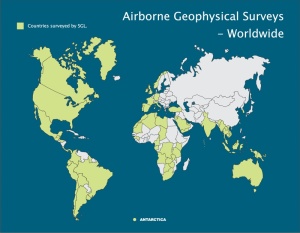Pilots at SGLTo Adventurous and Enthusiastic
Pilots
The SGL de Havilland DHC-6 Twin Otter at the head office
Sander Geophysics is looking for
enthusiastic, safe and adventurous pilots to join our
worldwide operations team.
What Do Pilots at SGL DoPilots at Sander Geophysics (SGL) conduct high precision low level day VFR flights to collect data for the company’s geophysical operations. Company pilots also ferry the aircraft under IFR to worldwide survey locations. All flight operations conducted at SGL involve two crew. An aerial survey may last a few days or may span multiple years but usually the flying portion of a survey lasts a few weeks to several months. Each field crew typically consists of one or more geophysicists, an AME, pilots, and a technician. SGL Cessna Grand Caravans in Bolivia Why Work for SGLSGL provides a unique and challenging experience for pilots providing the ability to create a lifetime of incredible memories exploring the world that is unmatched at any other job. Flying low, sometimes as low as 60 meters, truly gives you the opportunity to see things from a bird’s-eye view. Additional job perks and benefits include, but are not limited to:

Countries where SGL has surveyed Sander Geophysics is aware that the job brings some unique challenges for any individual. Pilots are provided with a comfortable and confidence inspiring learning environment and support is offered 24/7. Pilots are encouraged to fly safely and efficiently. Conservative decision-making is encouraged and pilots are fully supported. Who SGL is Looking For outlines the company's requirements and priorities for new pilot hires. The AircraftSander Geophysics owns eight Cessna 208B Grand Caravans, two de Havilland DHC-6 Twin Otters, and two Airbus Helicopters AS350 B3s. Twin Otter in Ireland A Day in the LifeA day in the life of a survey pilot starts the night before. Pilots group together to plan the next day’s work. The crew may go out for supper together. If you’re in a hot climate, you would buy water and put a few bottles in your hotel room fridge freezer. The project’s lead field pilot will coordinate the departure to the airport in the morning. The day often starts before sunrise. The crew meets up for breakfast and reviews any last minute changes and then heads over to the airport. How difficult or easy it is to access the aircraft depends on the airport you are operating from. At the aircraft, captain and copilot divide preflight duties. Survey flights are 6 to 8 hours long depending on the survey equipment configuration. Perhaps there will be pristine snow capped mountains, or thick dense jungle to view today, the shifting sands of a vast desert or perhaps you may spot a herd of caribou. During the flight, you stay hydrated and fed with what you brought. The flight crew may bring music or podcasts to listen to on a wired connection to their headset. This is only really possible in quiet airspace; if you are near a control zone, there often is too much radio chatter to listen to music. The airplane lands and taxis back to its parking spot. Hopefully the fuel truck is there waiting. You monitor the fueling while “putting the airplane to bed” (plugs and tie-downs). The Captain fills in the logbook with the times and snags. The iPad is updated with the correct times and the lines are crossed off. You may have to wait for the other SGL plane to arrive back at the survey base. Ferrying the Grand Caravan through Guatemala The crew drives back to the hotel. Once there you go to the field office and give the Garmin to the Crew Chief/Geophysicist. You fill them in on any complication you may have had on the flight and pass on anything relevant to them. You upload the paperwork and email the times. Plans are made for supper with your crew mates. But the afternoon may be taken up with a trip to the gym or doing groceries. The evening will involve planning, dinner, and perhaps Netflix then bed. Hopefully there are no noisy neighbours at the hotel and you’re in bed early to get a good night’s rest as the morning comes quick. What SGL Offers You
Why SGL?SGL is a world class establishment and a leader in the airborne geophysical survey business. We are looking for committed and adventurous pilots. SGL stands out due to its positive and open attitude and for the opportunities it provides and its commitment to safety. Sander Geophysics is a founding member of the International Airborne Geophysics Safety Association (IAGSA) which promotes the safe operation of helicopters and fixed-wing aircraft on airborne geophysical surveys. SGL has operated in every continent including Antarctica, and this allows you the chance to see the world while working. Please see details regarding the Hiring Process.
|

